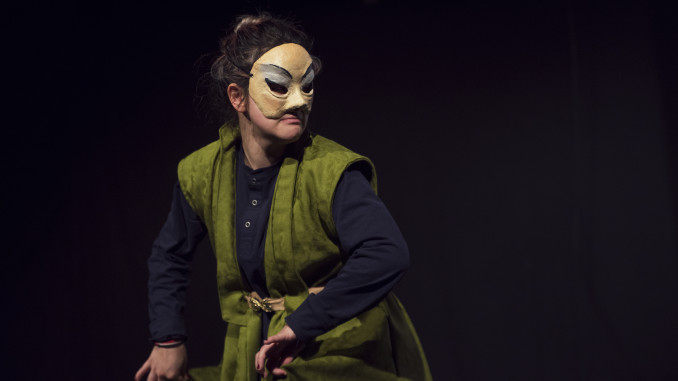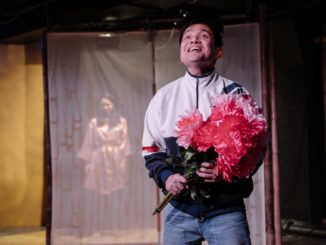
[Reasons to be Proud]
From their modest beginnings with productions of David Henry Hwang’s FOB and Renee Liang’s Lantern, Proudly Asian Theatre have proven themselves as a necessary presence within the local theatre scene. Developed over the last two years using Short + Sweet as a testing ground, Call of the Sparrows is the culmination of their hard work and represents many firsts for the company. It’s their first show since rebranding the company from original name Pretty Asian Theatre; it’s co-founders Chye-Ling Huang and James Roque’s full-length debut as both writer and director respectively; and the first professional debut for many of their actors.
Split into two distinct acts, the first half of the play sets up a conventional – but nonetheless entertaining – hero’s journey featuring underdog Little Sparrow (Amanda Grace Leo), who has recently been arranged to marry the head of a hidden mountaintop village. While she waits for her husband-to-be’s return, she has to prove herself worthy to her disapproving mother-in-law Joa Joa (Alice Canton). The narrative moves at an energetic and compelling pace, building the world of this village through the eyes of Little Sparrow. It quickly reveals itself to be a society with a capitalistic and class-based hierarchy, set amongst a backdrop of superstition and tradition.
This is an epic yet domestic fantasy that recalls the magical worlds of Hayao Miyazaki and the period dramas of Zhang Yimou all at once. But more than just mining the history of Asian pop culture and aesthetics, there is a deep understanding of visual storytelling thoughtfully integrated into the process. From the opening sequence of Little Sparrow arriving at the village, using puppetry and projection to show a journey across the sea and up a mountain, you know you’re watching something special.
Leo makes a relatable audience surrogate, playing bemusement and innocence that belies a greater passion and desperation. The ensemble have more opportunities to shine as the numerous characters who populate the village. Huang’s potato seller and poltergeist, Canton’s wicked mother-in-law, and Ravi Guranathan’s lady of leisure, are all highlights and examples of stellar character work. Sarah Nessia excels, despite limited character development, in bringing a confident and controlled air to the cartoonish world as The Head of The Flock. Nikita Tu-Bryant, while functioning as the show’s live musician, also makes a mark as a mysterious fisherman. Though showcasing the talents of its all-Asian cast is a worthy cause, the fact they’re given this opportunity without being subjected to playing lazy stereotypes is the real achievement.
As wonderful as Huang’s world building is, it’s equally matched by Roque’s directorial vision, and brought to life by all the constituent design elements. Christine Urquhart’s spare set manages to evoke a timeless world that captures the essence of the play without being overtly or crudely Asian. The unique masks, also designed by Urquhart with Catherine Ellis, are also brilliantly versatile, often accentuating rather than obscuring faces. But regardless of whether we’re talking about mask, projection, shadow play or music, these elements are all brilliantly realised in all aspects of the play.
In a narratively daring move, the second act flips the script and changes the course of the play in a way that would make George R. R. Martin grin. Without spoiling too much, Huang derails the expected hero’s journey, pushing Little Sparrow into the background of the action and introducing a new cast of characters and new conflict. No longer is this the story of a woman trying to find her place in a village. This becomes, instead, the story of a political upheaval with more than a few echoes of communism. Even more surprising than the sudden injection of socio-political commentary is the even-handed way its explored. This isn’t simply a fight between good versus evil, this is a complex clash of ideologies.
But while it’s thematically compelling, the execution introduces a lot of problems into the show. Gone is the economy of visual storytelling and unrushed world building in the first half. And along with several new characters we also have to adjust to a shifting status quo. So, despite a greater sense of urgency and higher stakes, everything becomes weighed down by heavy exposition. Huang’s strongest asset, her exemplary imagination, suffers here because it ends up feeling like an entire fantasy saga worth of material has been condensed into a single act. The resulting effect is very dramatic and never boring, but occasionally lacking in clarity.
Though the play stumbles in the second half, it can’t be accused of lack of ambition. PAT aims for the stars and, for the most part, soars to new heights. Though the work still has plenty of untapped potential, and a definitive version remains to be seen, anyone with any interest in the future of the arts would be foolish to miss this brief but important development season.
This is a company whose values aspire to reflect an entire cultural movement happening all around us, of our stories slowly beginning to reflect our communities. While some will find the play’s lack of content dealing directly with Asian identity politics to be a missed opportunity, any work by Asian artists questions the notions of Asian-ness and tokenism by sheer virtue of existence. The very act of populating a major theatre venue with Asian actors led by Asian theatremakers is revolutionary. Even if it shouldn’t be.
Call of the Sparrows is presented by Proudly Asian Theatre with the Oryza Foundation and Auckland Live and plays at the Herald until 16 Oct. Details see Auckland Live.
SEE ALSO: Theatreview.org.nz review by Nik Smythe




Leave a Reply